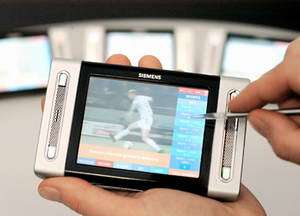Cell Phone Calls With the TV – Siemens Presents DVB-H

In the future, it will not only be possible to receive digital TV while on the road; viewers will also be able to help shape the content of broadcasts interactively. At CeBIT in Hanover, Siemens is introducing the prototype of a new multimedia device with this capability. It combines the functions of a television set and a mobile phone.
The device with the new DVB-H transmission standard (Digital Video Broadcast Handheld) for digital TV makes it possible to not only receive information but also to simultaneously send it through the return channel of the radio communications standard used. With the touch screen of the multimedia device, for example, users can send the broadcasting station a text message with their preferences during the broadcast. The broadcaster can evaluate the text message and incorporate the results directly into the program. This way, music channels could get viewers involved. While the user is watching a broadcast, he or she can switch over to the telephone mode or use the built-in recorder function to record extended sequences of the ongoing program in the internal 128 megabytes of memory or on an external memory card. DVB-H can also be used to receive current movie listings along with short trailers and immediately reserve a seat in the theater via the return channel.
The multimedia unit, which is about as large as a pocket calendar, contains a 1.3-megapixel digital camera and offers all the functions of the Siemens S65 cell phone. This includes use of the tri-band standard, for example, which makes it possible to place calls in all GSM cell phone networks worldwide. The two integrated speakers next to the large-format display help the device to achieve amazingly rich stereo sound. And the multimedia unit could support the existing services of television broadcasters, such as transmissions of traffic information, current news or weather forecasts.
For commercial use of the devices, television broadcasters and other information providers will transmit their broadcasting signal in the standardized MPEG-4 format, which will then be converted to the DVB-H format by a receiving station and transmitted to the terminal. The information is transmitted to the device in time slots, as small packets, and the resulting brief transmission pauses contribute a lot to prolonging battery life. In fact, the device can receive television images for up to three hours.
At CeBIT, visitors will be able to use the devices to receive the television stations N24, Deutsche Welle, Viva Plus and a weather channel. What’s more, Siemens will broadcast live images of the trade show. Siemens Communications and the mobile communications provider Vodafone will soon begin a field test with more than 100 terminals in a major German city. Vodafone will also be presenting the multimedia units at the trade show. Cell phones with DVB-H technology are expected on the market in 2006.



















